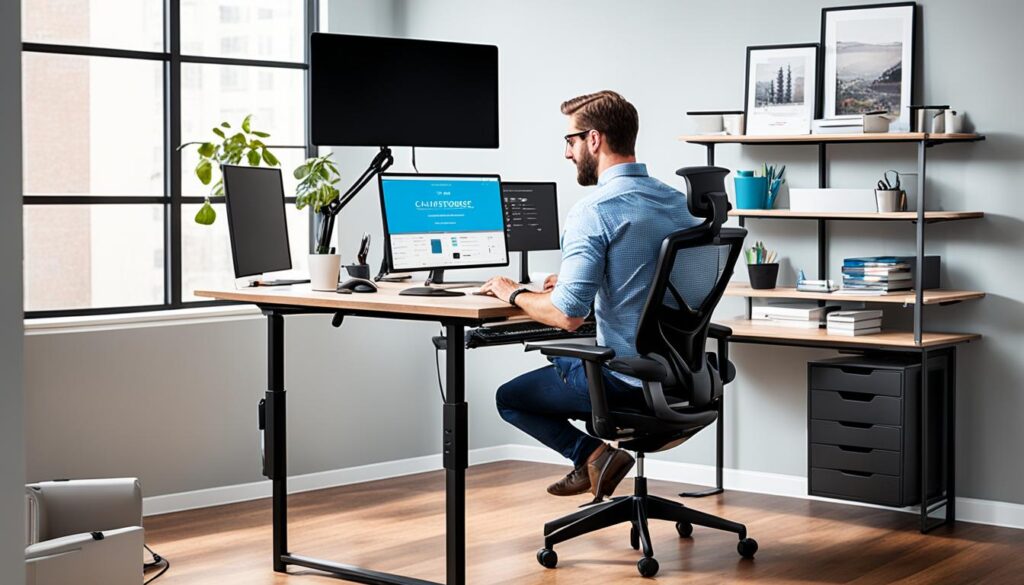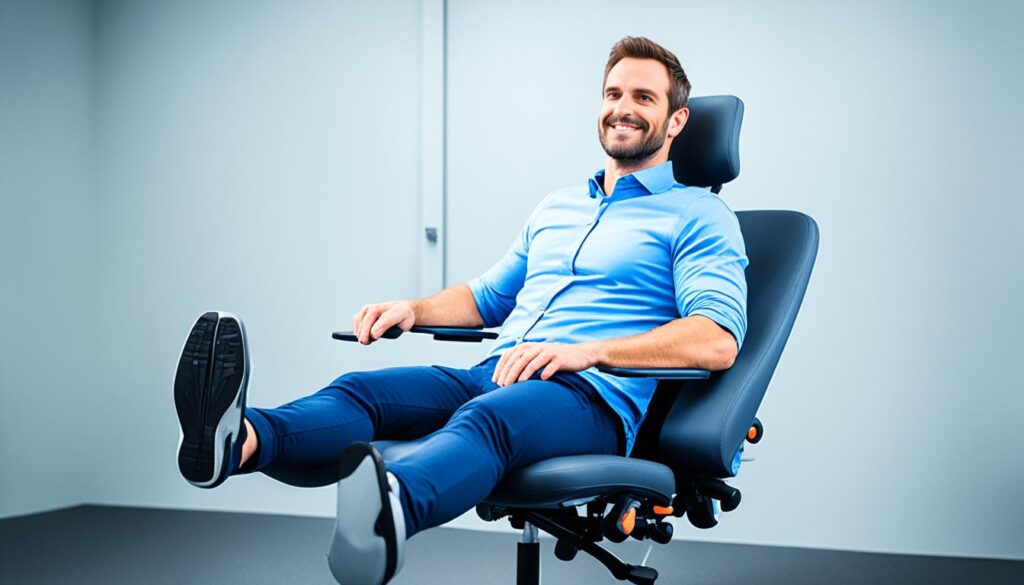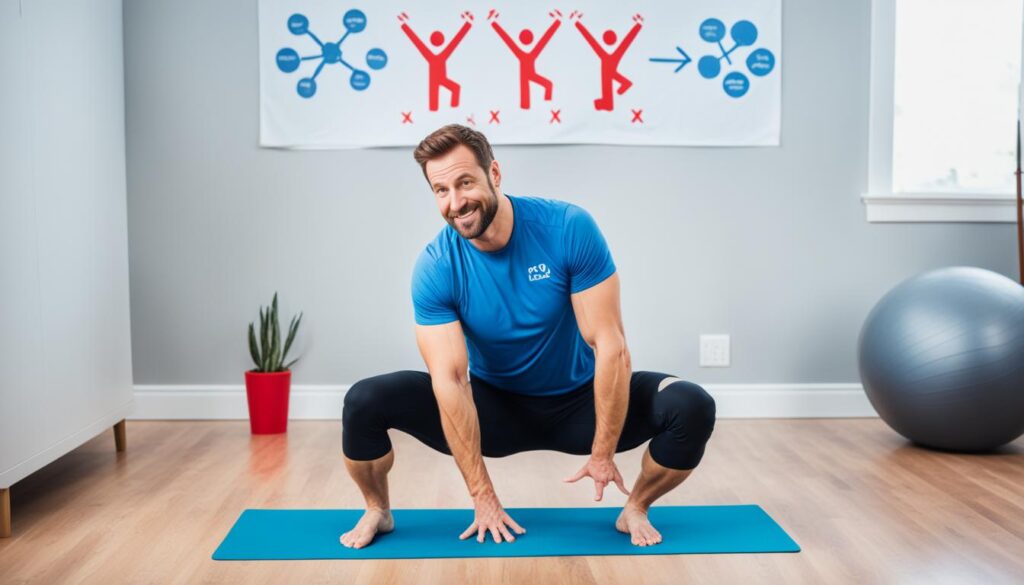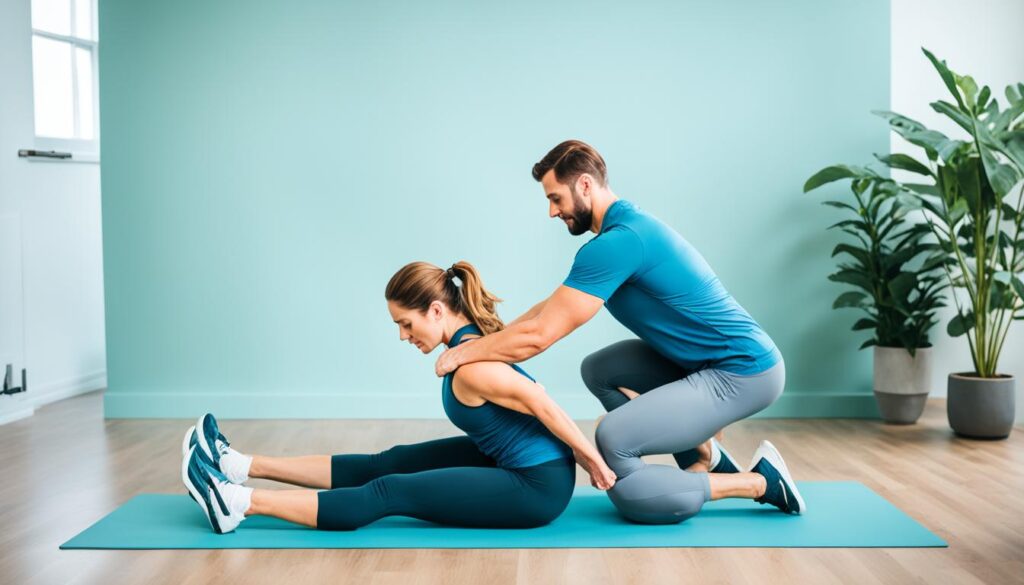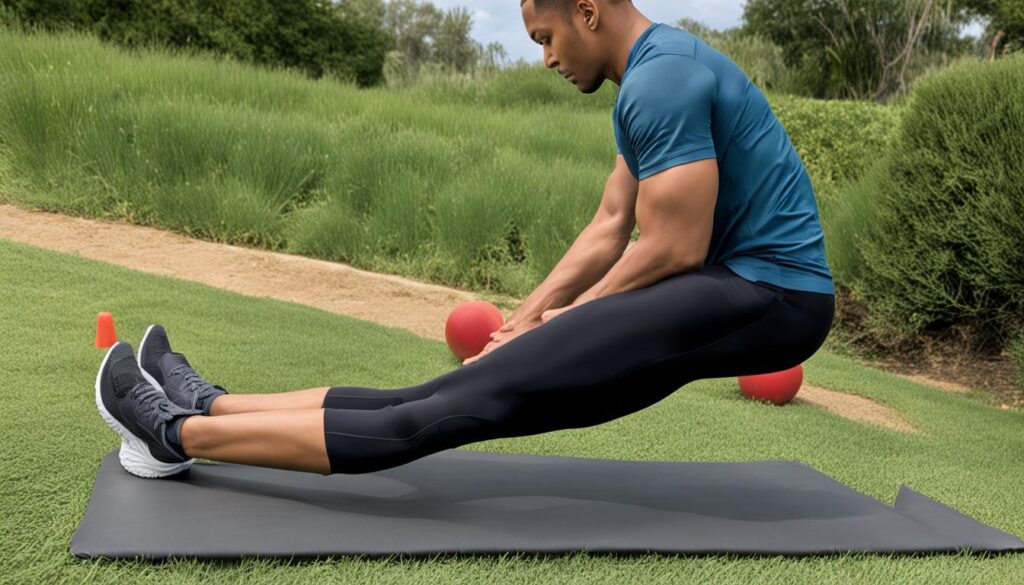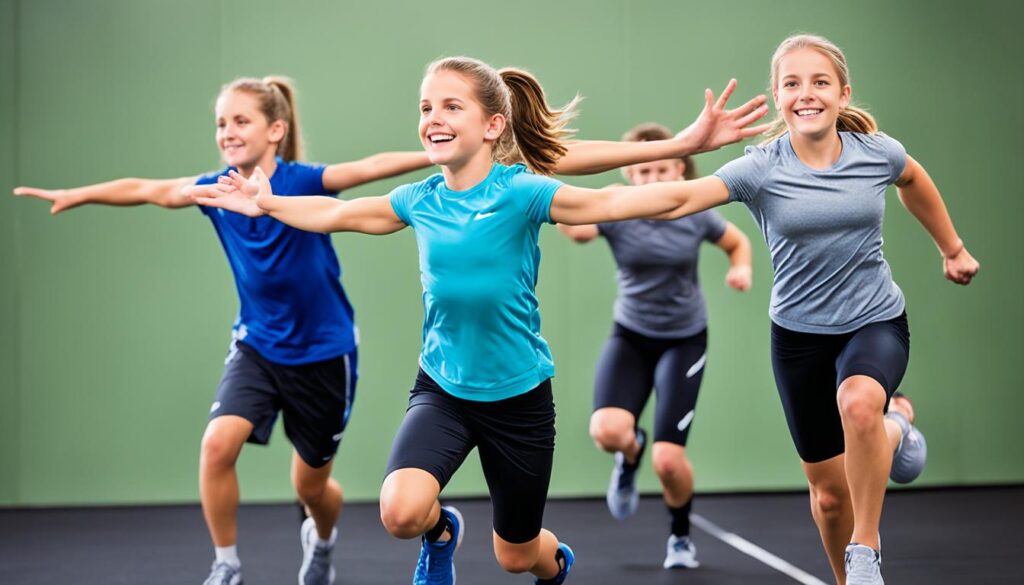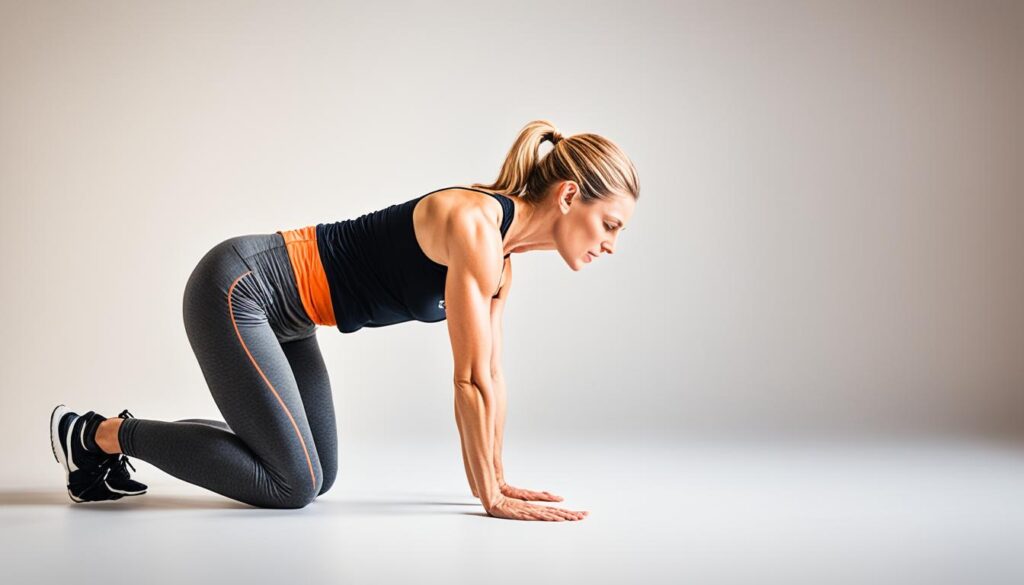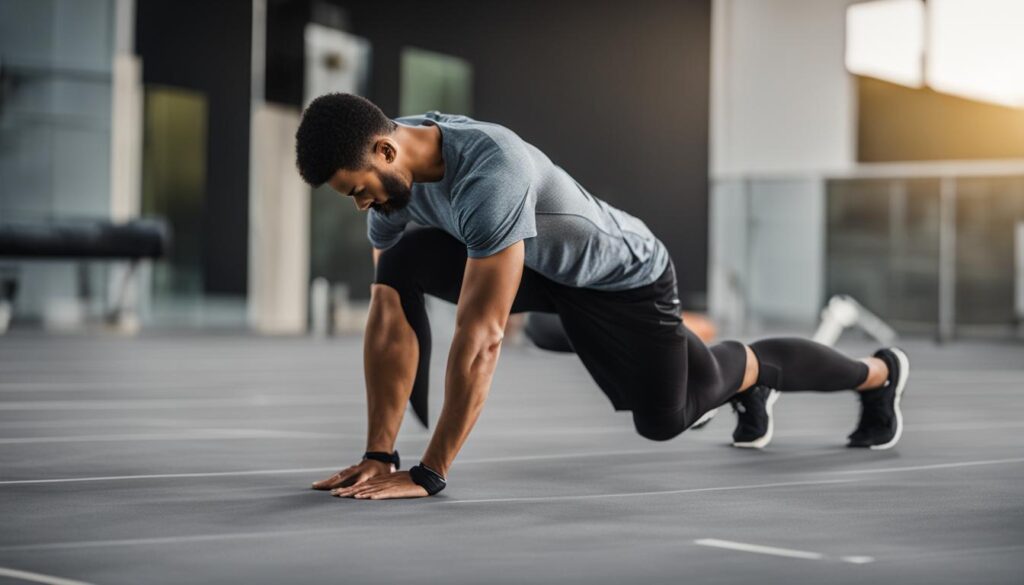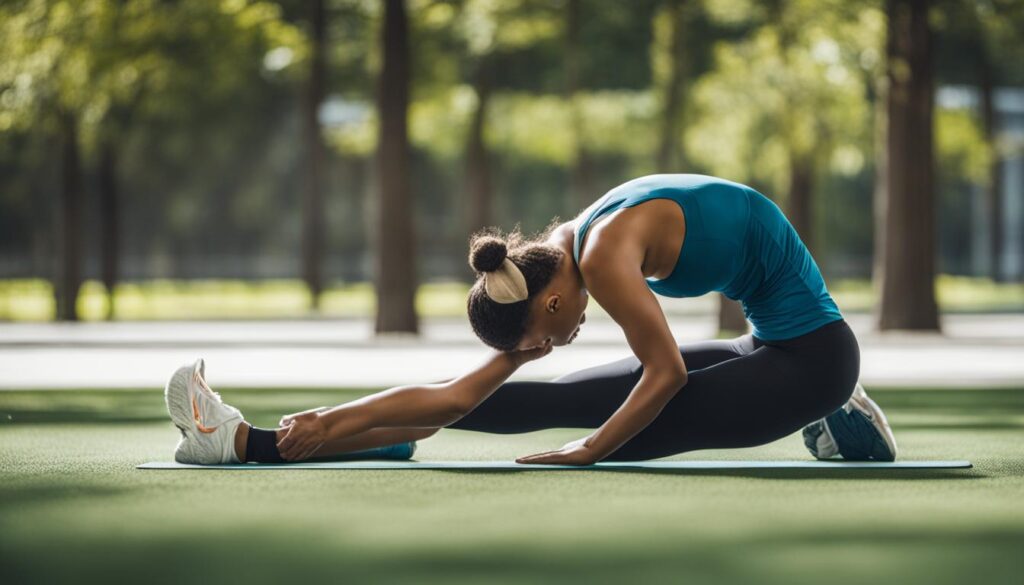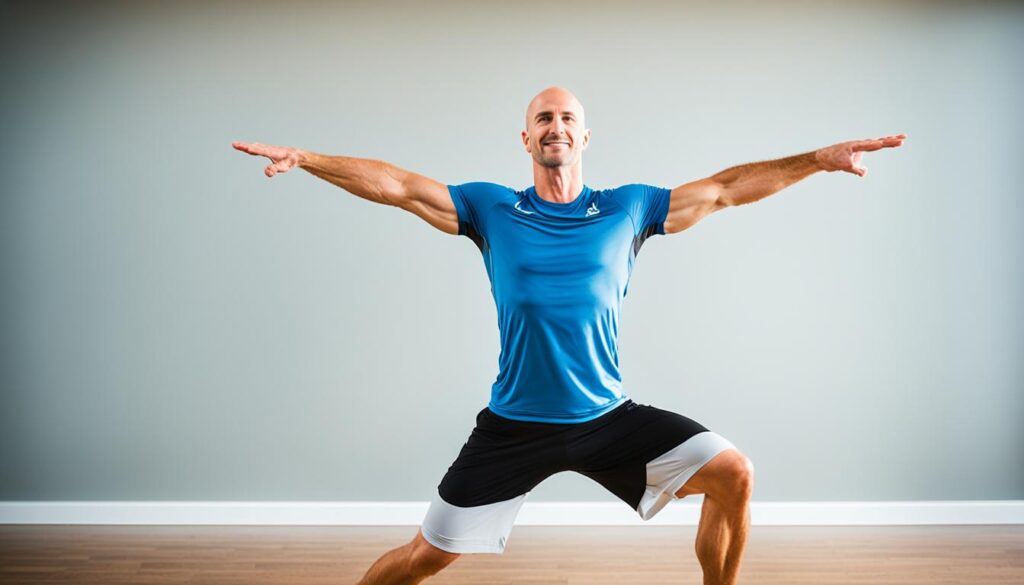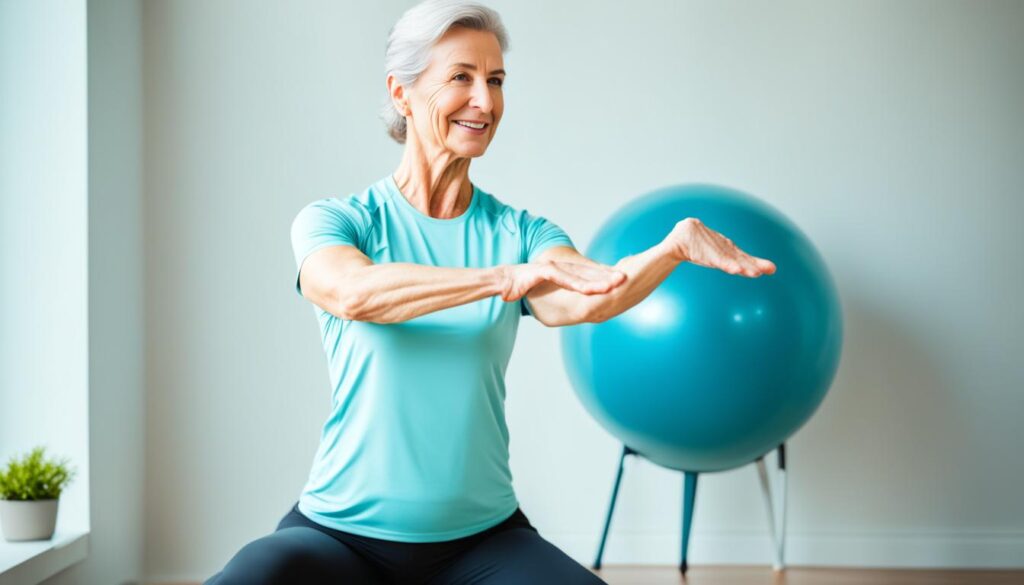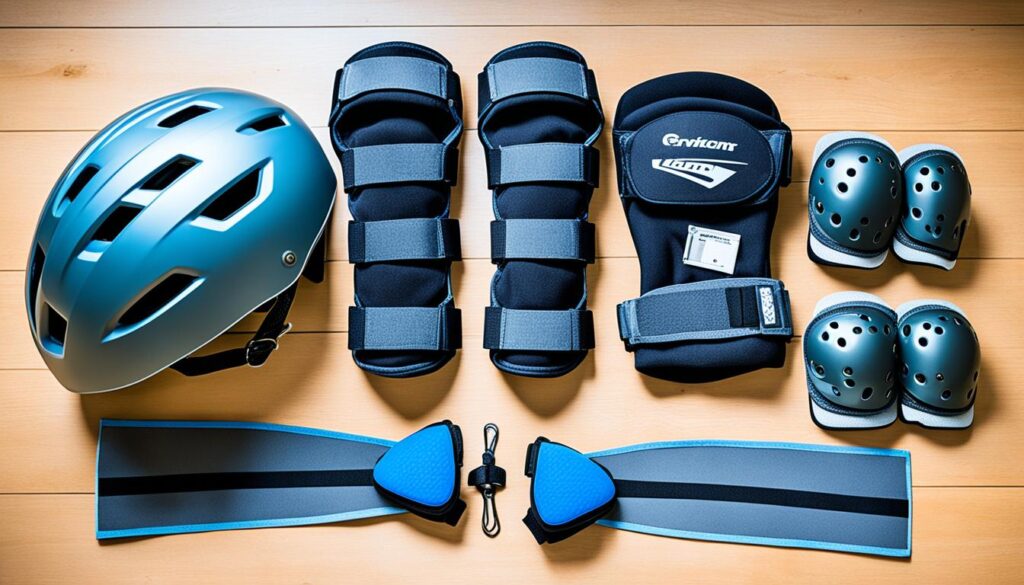Your posture does more than just make you look good. It’s key to stopping injuries and getting better health. Our modern sitting-all-day lifestyle makes it hard to keep a good posture. So, what can you do to keep your back healthy and stay free from pain?
We’re going to give you 12 top tips for great posture. We’ll cover exercises, how to set up your workspace, and why stretching and making your muscles stronger matter. Find out how good posture can benefit you in surprising ways. Learn easy steps to improve your posture every day.
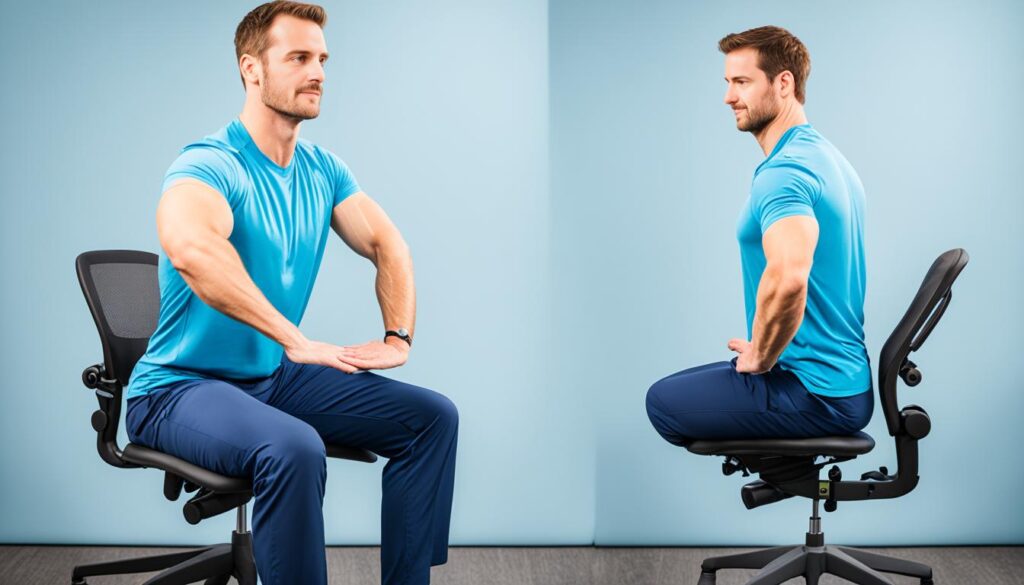
Key Takeaways:
- Good posture is crucial for preventing injuries and improving overall health.
- Exercises and ergonomic workspace setup can help correct and maintain proper posture.
- Stretching and strengthening are essential for supporting the spine and improving posture.
- Moving often and making lifestyle changes can contribute to better posture.
- Implementing tips and exercises throughout the day can help you maintain proper posture and prevent injuries.
The Importance of Good Posture
Good posture is crucial, no matter your position. It’s about how our bodies are aligned. Keeping the right posture is key to avoiding many health issues. If our posture is bad, we might face muscle and bone problems. This can lead to pain and affect how we move every day. By focusing on good posture, we improve our health and feel better.
With good posture, your body aligns properly. This keeps your spine natural. It means weight spreads out evenly, easing pressure on muscles and joints. Proper posture also lets organs work better. This means easier breathing and digestion for you.
There are many pluses to keeping your posture right. Here are some:
- Lower chance of musculoskeletal problems
- Better circulation and organ function
- Stronger core
- More confidence
- Less back and neck pain
- More energy and productivity
- Better balance and coordination
Good posture matters whether you’re sitting still or moving around. It keeps your spine happy. This reduces the risk of back pain and other spine issues.
Doing posture-improving exercises is beneficial. Think about stretching and strengthening your muscles. These activities ease tension and help with alignment. Also, setting up an ergonomic workspace is crucial. This means adjusting your desk, chair, and computer for better posture, especially if you sit a lot.
“Good posture isn’t just standing tall. It’s about aligning your body for better health and happiness.”
Try to keep good posture all day. This helps avoid the downsides of slouching. Be mindful of your posture at work, home, or when active. Do regular exercises and adjust your surroundings for the best posture. This will support a healthy spine.
Exercises to Correct Posture
Good posture is key for a healthy spine and avoiding injuries. There are easy exercises to better your posture. These can help you become more aware of how you align your body. With time and focus on these exercises, you can fix your posture.
Upper Cross Syndrome
Upper cross syndrome is when your chest, neck, and upper back muscles don’t balance. It causes rounded shoulders and forward head posture, raising the injury risk. Here’s how to tackle upper cross syndrome:
- Doorway Stretch: Stand in a doorway, elbows at 90 degrees, forearms on the frame. Lean forward gently to stretch your chest and shoulders.
- Chin Tucks: Sit or stand straight, tuck your chin inwards like making a double chin. Hold it, then repeat.
Lower Cross Syndrome
Lower cross syndrome involves weak abs and glutes but tight hip flexors and back muscles. It can make your lower back arch too much, causing pain. To fix lower cross syndrome:
- Glute Bridges: Lie down, knees bent, feet flat. Raise your hips, squeeze your glutes. Aim for a straight line from knees to shoulders.
- Hip Flexor Stretch: Kneel on one knee, other foot flat and forward. Lean into the stretch. Hold for 30 seconds, then swap sides
Proper Lying Down Posture
How you lie down affects your posture and spine health. Wrong sleeping positions can strain muscles and harm your spine. To keep your lying down posture right:
- Use Supportive Pillows: Get a pillow that supports your head and aligns your neck and spine. Use more pillows for extra cushioning where needed.
- Sleep on Your Side or Back: Don’t sleep on your stomach as it strains neck and back. Sleep on your side or back, using pillows for alignment.
Practice these exercises and pay attention to how you lie down, sit, and stand. Over time, you can improve your posture and dodge injuries from bad posture.
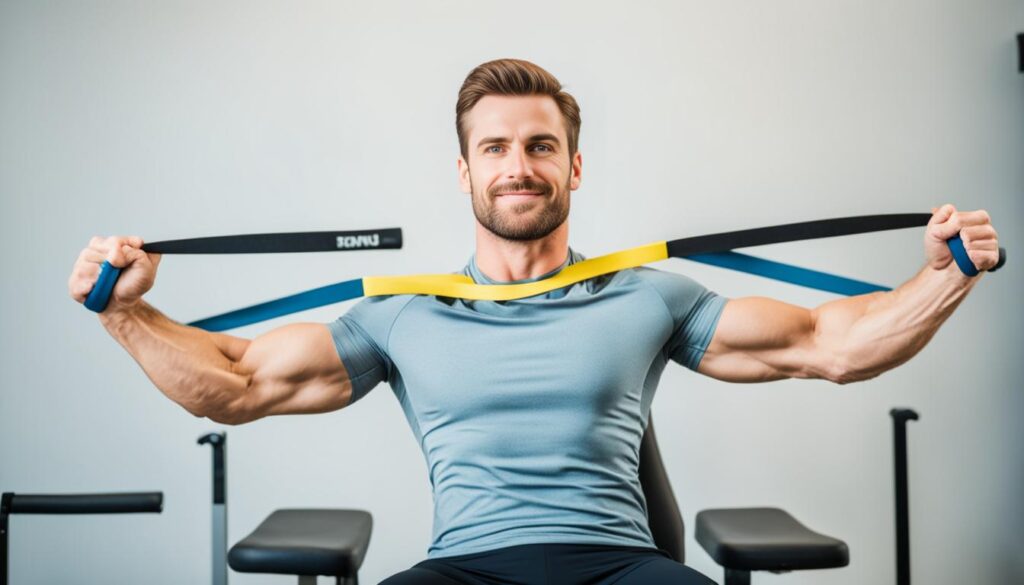
The Importance of Stretching and Strengthening
Stretching and strengthening exercises are key for good posture. Stretching relieves tight muscles and prevents stiffness. Strengthening supports your spine and body alignment.
Stretching makes tight muscles longer. This happens from sitting too much or bad posture. It brings more blood to your muscles. This lowers injury risks and improves your posture. Doing stretches every day helps avoid injuries from poor posture.
Strengthening exercises focus on important posture muscles. They make your back, core, hips, and legs stronger. These muscles support your body’s alignment. Stronger muscles mean better posture and less spine strain.
Here are examples of exercises for posture:
Stretching Exercises for Posture Improvement:
- Neck stretches
- Shoulder rolls
- Chest openers
- Upper back stretches
- Hamstring stretches
- Calf stretches
Strengthening Exercises for Posture Support:
- Plank exercises
- Bridge pose
- Squats
- Lunges
- Superman exercises
- Seated rows
Before starting exercises, talk to a healthcare professional or a fitness instructor. They can give advice based on your needs and abilities.
Stretching and strengthening exercises can really improve your posture. They also prevent injuries and give you a strong, aligned body over time.

Benefits of Stretching
Stretching your muscles can really help your posture and overall well-being. It eases muscle tightness and boosts balance, flexibility, and spine health. Adding stretching to your daily life helps keep your posture right and prevents injuries.
But, you need to stretch the right way. There’s a line between a good stretch and pain from stretching too far. Knowing this difference makes your stretching more effective. This way, you get all the good from stretching without hurting yourself.
Stretching lets you release muscle tension. This helps fix muscle imbalances that cause bad posture. Your muscles get longer, helping your body balance and keep its natural shape.
It also makes you more flexible and able to move easily. Being flexible stops discomfort and stiffness, which can mess up your posture.
Stretching is key for your spine too. Doing stretches for your spine muscles keeps your spine aligned. This lowers pressure on your discs and lessens the chance of spine problems.
By adding stretching to your routine, you help your spine stay straight. This cuts down strain on your back.

Regular stretching not only improves your posture but also prevents strain injuries and promotes overall spine health.
Strengthening for Good Posture
Strengthening exercises are vital for proper posture. Weak muscles can hurt your joints and make it hard to stay aligned. You can improve your muscle strength to support good posture by focusing on certain areas of your body.
Key Areas to Focus On
Several body parts are crucial for maintaining good posture:
- Shoulders and Upper Back: Strengthening these helps keep your shoulders aligned and prevents them from rounding.
- Core Muscles: A strong core keeps your spine stable. This reduces slouching and helps keep a good posture.
- Hips: Strong hip muscles, like the glutes and hip flexors, are important. They help keep your pelvis and spine in the right position.
- Legs: Having strong legs, including the quadriceps and hamstrings, supports your body’s weight and balance.
Adding exercises that target these areas to your workouts can build strength. It also improves your posture and lowers injury risks.
Good posture is more than sitting up straight. It involves stretching, strengthening, and paying attention to how your body lines up. By working on strengthening key muscles, you support your posture and spine health.
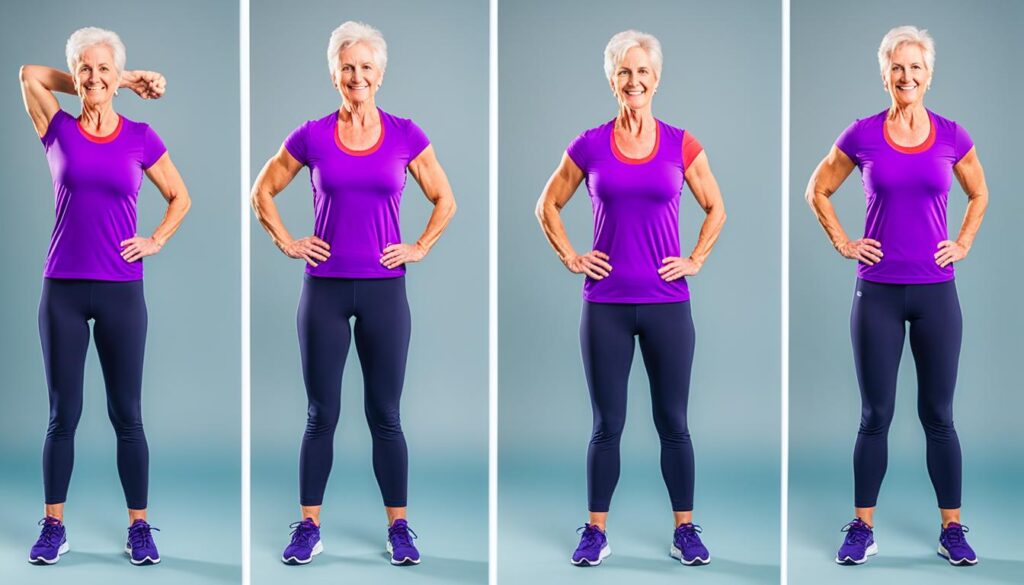
Sample Strengthening Exercises
Here are a few example exercises to strengthen important areas mentioned:
| Exercise | Targeted Area |
|---|---|
| Rows | Shoulders and Upper Back |
| Planks | Core Muscles |
| Bridges | Hips and Glutes |
| Squats | Legs |
Before trying any new exercises, check with a healthcare or fitness pro. This is especially important if you have any medical issues or worries.
By making these posture exercises part of your fitness plan, you can make key body areas stronger. This helps your muscle support and keeps your posture right.
Moving Often for Better Posture
It’s vital to keep a good posture for injury prevention and health. But just holding a pose isn’t enough. Moving regularly helps keep your posture right and reduces discomfort.
Sitting or standing too long can make muscles stiff and sore. You should often check your posture. Also, make time to stretch and move. This helps keep your posture on point.
Want to move more in your day? Try these tips:
- Set reminders: Use tech to remind you to move. A simple walk every hour can make a difference.
- Stretch breaks: Stretch often to ease muscle tension. Simple neck, shoulder, and back stretches work well.
- Walk and talk: Move around during phone calls. A wireless headset or speakerphone makes this easy.
- Active transportation: Choose walking or biking over driving. It adds movement to your day and has health perks.
- Take the stairs: Using stairs works your muscles, boosts heart health, and helps posture.
Good posture isn’t just about how you stand or sit. It’s also about moving. Regular movement fights injuries, eases tension, and boosts your health.
Benefits of Regular Movement for Posture
| Benefits | Explanation |
|---|---|
| Improved muscle flexibility | Movement keeps muscles flexible, helping avoid imbalance that affects posture. |
| Increased blood circulation | Moving boosts blood flow. This gives muscles nutrients and oxygen, making them work better. |
| Strengthened core muscles | Walking and stairs make core muscles strong. This supports your spine for better posture. |
| Reduced risk of musculoskeletal disorders | Moving helps avoid disorders from bad posture like back and neck pain. |
| Enhanced mood and mental well-being | Regular movement makes endorphins. This improves mood and reduces stress. |

“Movement is key to maintaining good posture. Incorporating regular breaks for stretching and walking can help alleviate muscle tension, improve flexibility, and reduce the risk of posture-related injuries. Keep your body in motion to keep your posture aligned.”
Lifestyle Changes for Better Posture
Making a few simple changes can really help your posture. These adjustments prevent injuries too. Let’s explore how to weave these into your day-to-day life for better posture and health.
Ergonomic Workspace Setup
An ergonomic workspace is key for good posture during work. Make sure your desk and chair support good posture. Your chair should let your feet rest flat and knees bend at 90 degrees.
Put your monitor at eye level. Your keyboard and mouse should be easy to reach. An ergonomic chair and keyboard give extra back and wrist support.
Sitting, Standing, and Sleeping
Be mindful of how you sit, stand, and sleep. When sitting, keep your feet flat and back straight. Don’t slouch or cross your legs for too long.
Distribute your weight evenly while standing. Avoid staying in one spot for too long. Pick a mattress and pillow that support your spine. Use a pillow between your knees for side sleeping to keep your hips aligned.
Regular Exercise and Stretching
Add exercise and stretching to your day to strengthen muscles and improve flexibility. Activities like walking, swimming, yoga, or Pilates boost your core. This helps with posture.
Try neck, chest, and hip stretches to ease tension and enhance flexibility. Regular movement is essential.
Remember, consistency is key when it comes to maintaining proper posture. Incorporating these lifestyle changes into your daily routine will help you see long-term benefits and prevent injuries.
Ergonomics, mindful sitting, standing, sleeping habits, plus regular exercise and stretching improve your posture and health.

Tips and Exercises for Maintaining Good Posture Throughout the Day
Proper posture is key to prevent injuries and keep you healthy. By using these tips and simple exercises every day, you can keep your posture right.
First, don’t slouch. Be aware of how you sit, stand, or lie down. Make sure to align your spine and relax your shoulders. This will ease muscle and joint strain, avoiding injuries.
Make some workplace and sleep changes for better posture. Have an ergonomic work area for body alignment. Use a comfy chair that backs your spine and neck.
Also, think about your sleep setup. A supportive mattress and pillow can keep your spine straight at night.
Last, add exercises and stretches to your day to stay aligned and avoid hurt. Strengthen your core, shoulders, and back. Stretch often to lessen muscle tension.
Simple daily adjustments can greatly improve your posture.
FAQ
Why is maintaining good posture important?
Maintaining good posture is key for your overall health. It helps prevent pain and stiffness. Good posture supports your muscles and bones.
It helps with daily activities and prevents health issues. The right posture means your body works better.
What exercises can help correct posture?
Many exercises can improve posture and your body’s alignment. Shoulder blade squeezes and thoracic spine rotations are good. Hip stretches also help.
Adding these exercises to your daily routine helps your posture. Your body will thank you by maintaining proper alignment.
Why is stretching important for posture?
Stretching is crucial for keeping a good posture. It loosens your muscles, improves flexibility, and prevents injuries. Regular stretching keeps muscles flexible and supports good posture.
It also reduces pain and discomfort. Keeping muscles elastic helps your posture and health.
How do strengthening exercises contribute to good posture?
Strengthening exercises are vital for good posture. Weak muscles make it hard to keep proper alignment. By strengthening your shoulders, upper back, and core, you improve posture.
Focus on your hips and legs too. This supports proper posture and muscle strength.
How does moving often help with maintaining good posture?
Staying in one position too long can cause pain. Moving regularly helps avoid this. It reduces muscle and joint strain.
Take breaks to move, stretch, and change positions. This helps keep your posture good and prevents stiffness.
What lifestyle changes can help improve posture?
Improving your lifestyle can boost your posture. An ergonomic workspace promotes proper alignment. Paying attention to your sitting, standing, and sleeping habits helps too.
Regular exercise and stretching are key. These changes lead to better posture and health.
What are some tips and exercises for maintaining good posture throughout the day?
Many tips and exercises can help with your posture daily. Avoid slouching and create an ergonomic work area. Pick the right shoes and stretch often.
Good posture habits while sitting, standing, and lying down are crucial. They help keep you aligned and injury-free.



